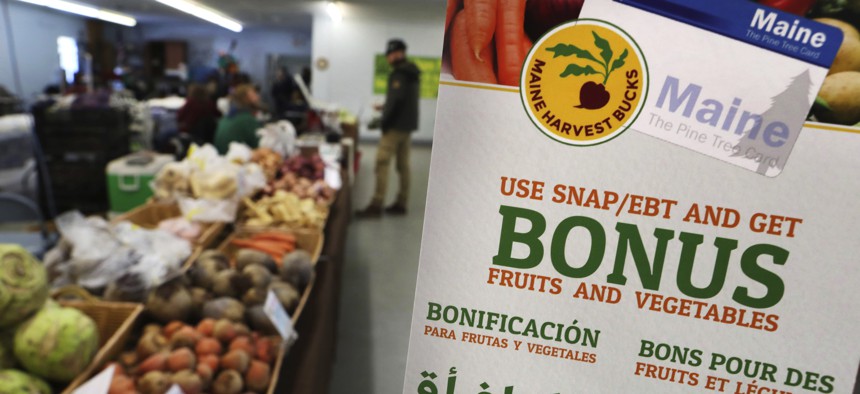A Trump Administration Proposal to Cut Food Stamps Would Cost States

In this Friday, March 17, 2017, file photo, a sign advertises a program that allows food stamp recipients to use their EBT cards to shop at a farmer's market in Topsham, Maine. Robert F. Bukaty/AP Photo
The proposal would cut 3.1 million people off of food stamps.
The Trump administration’s proposal to change the way states determine who is eligible for food stamps would cut benefits for more than 3 million people and cost states additional money to vet recipients, according to policy analysts.
The Department of Agriculture published a proposal Tuesday that would tighten eligibility requirements for some recipients of food stamps, also known as the Supplemental Nutrition Assistance Program. The administration said it wants to “fix a loophole” that has allowed states to provide food assistance to residents who would otherwise not meet the low-income and asset limitations.
“For too long, this loophole has been used to effectively bypass important eligibility guidelines,” said U.S. Secretary of Agriculture Sonny Perdue. “Too often, states have misused this flexibility without restraint.”
The proposal would have ramifications across 39 states, as well as in Washington, D.C., Guam and Puerto Rico. In each of those places, residents are able to automatically qualify for food stamps if they receive federal welfare benefits. Doing away with automatic enrollment of recipients would require states to enforce new eligibility requirements.
“It will cost states money to do it,” said Elaine Waxman, a senior fellow at the Urban Institute. “States have built their systems and processes around the more streamlined eligibility approach. And now they will have to do another layer of review and potentially change their benefits systems.”
To qualify for SNAP, individuals must earn less than 130 percent of the federal poverty guidelines, or approximately $2,252 a month for a family of three. But through what is referred to as “broad-based categorical eligibility,” states are able to choose whether to extend benefits to people with incomes as high as 200 percent of the poverty line. Each state is able to set its own income limits and asset requirements, flexibility that advocates of food assistance programs said allows low-income working families to qualify when a significant portion of their income goes towards rent or child care and can allow recipients to accumulate modest savings without losing food assistance benefits.
The Department of Agriculture estimates that cutting people from SNAP who have been covered through broad-based categorical eligibility will save $2.5 billion annually. However, a budget analysis of the proposal included in the Federal Register estimates that the rule will increase the agency’s administrative costs of running the program by $2.3 billion over five years.
The federal government covers the cost of SNAP benefits but splits administrative costs with the states. The USDA proposal estimates a $1.15 billion increase in federal administrative costs and a $1.15 billion increase in federal reimbursement of administrative costs to state agencies.
“They seem to be willing to see those claims go up both for the feds and the states,” said Ellen Vollinger, legal director for the Food Research and Action Center of the USDA proposal. “There is an increase in the cost because it’s going to be more time consuming, more red tape, more barriers. Even USDA admits it will have that negative effect in terms of streamlining.”
Approximately 40.3 million people in 20 million low-income households were enrolled in SNAP in fiscal 2018. The federal government spent approximately $68 billion on SNAP and related food assistance programs that year, according to the Center on Budget and Policy Priorities.
The proposed rule has not taken effect and the public has 60 days to submit comments on it.
It is unclear what it would cost each state to enforce the requirements, but Mississippi is anticipating significant upfront costs associated with its own elimination of the broad-based categorical eligibility this month. The state expects to spend at least $1.5 million in upfront costs to establish a way to check the assets of SNAP recipients to determine eligibility for the program, John Davis, the executive director of Mississippi’s Department of Human Services, told a congressional committee last month.
“This requires cooperation and automation between state agencies, financial institutions, etc.,” Davis told the U.S. House of Representatives Committee on Agriculture during a hearing on SNAP last month. “The agreements with state agencies would not be difficult, but automation would be very expensive requiring an initial up-front investment of state funds.”
In addition to requiring states to enforce the asset and income limits, states would also likely have to absorb the unmet needs of residents, Vollinger said.
“One of the other things we see generally when the federal government pulls back from providing certain key benefits particularly within SNAP, it doesn’t mean the need went away,” she said. “It means the costs of dealing with that are shifted. It means the states where they are located will see more need and hunger.”
Andrea Noble is a staff correspondent for Route Fifty.
NEXT STORY: States Are Making Periods Easier with Free Menstrual Products in School Bathrooms





